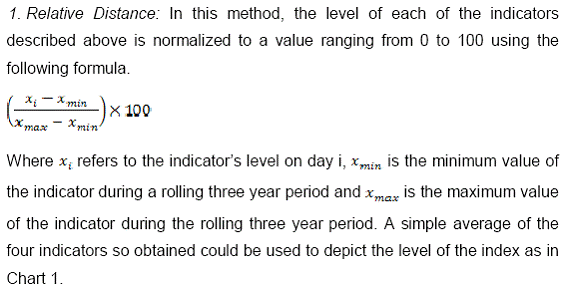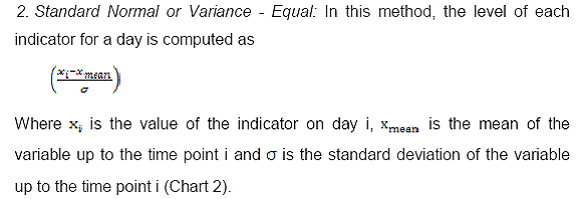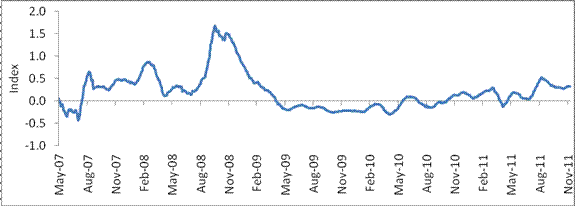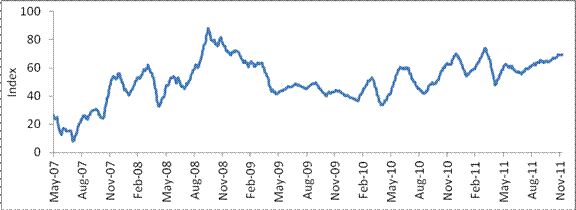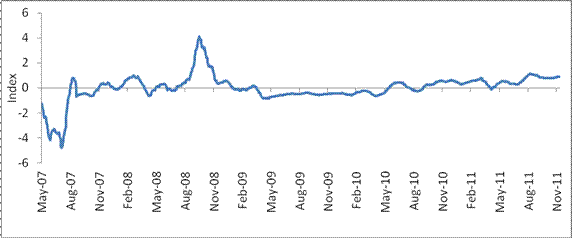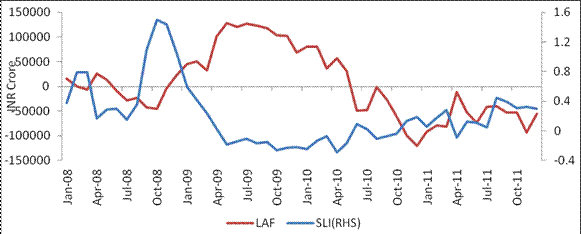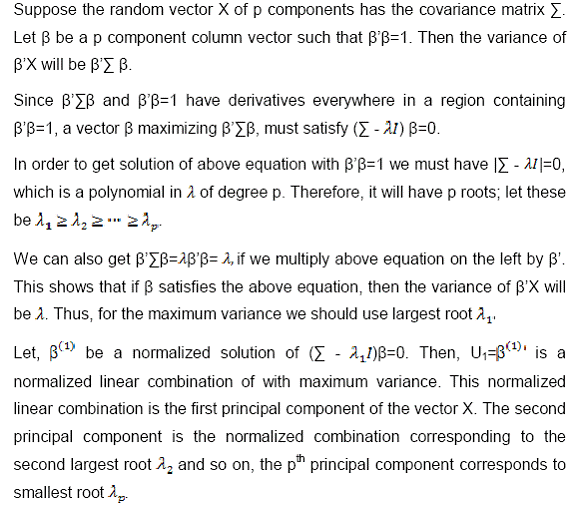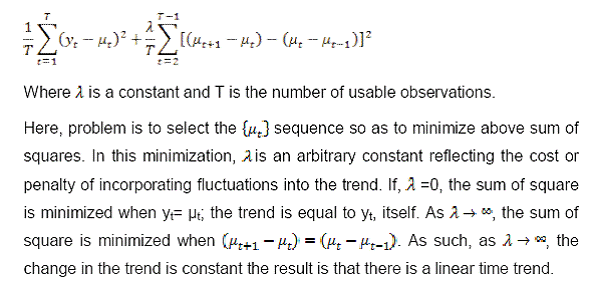 IST,
IST,
RBI WPS (DEPR): 10/2012: Systemic Liquidity Index for India
| RBI Working Paper Series No. 10 Abstract *Stress in liquidity is at the heart of any banking crisis in history. During the financial crisis of 2007-09, funding liquidity risk caused the collapse of interbank markets, which became the focus of authorities’ attention at restoring order. Accordingly, central banks and other regulatory bodies world-wide have been evolving prudential liquidity norms in order to impart stability to financial systems. Apart from implementing newer norms on liquidity, they have been devising ways of assessing objectively liquidity conditions in the markets. As an end to this objective, various central banks have started identifying the indicators of liquidity and preparing a composite index thereof in order to have a bird’s eye view of liquidity conditions across financial markets. In this study, a systemic liquidity index (SLI) is constructed considering prevailing rate variables across different financial markets in India. The SLI, so developed, is appropriately validated for its function as a metric for measuring systemic liquidity and its implications on the banks’ performance. JEL classification: E4, G1, F3, Key words : Funding Liquidity, Systemic Liquidity Index, Financial Crisis, Global liquidity. Introduction “Unfortunately the word ‘liquidity’ has so many facets that is often counter-productive to use it without further and closer definition” - Charles Goodhart (Banque de France, 2008) The financial crisis of 2007-09 originated in the relatively small subprime lending market of the US, but engulfed the world financial markets very quickly and had devastating effect on the global economy. One of the important characteristics of this crisis was the existence of simultaneous liquidity problems across financial institutions and financial markets spread across many countries. In order to avoid such liquidity problems in future, central banks and international regulatory bodies have initiated a series of policy measures such as introduction of Basel III norms which stipulates more stringent norms of capital adequacy and maintaining higher level of funding liquidity. Notwithstanding the financial crisis of 2007-09, central banks in fact have been concerned with the liquidity problems since their inception. Fractional reserve banking systems are prone to bank runs as only a fraction of their demand and time liabilities are readily available for use at any point of time. Central banks were vested with the Lender of Last Resort (LoLR)1 function to prevent the failure of bank(s) due to the problems of funding liquidity. They were created to lend freely at penalty rates against good collateral to illiquid but solvent banks so that the occurrence of banking crisis could be minimised. Besides, evolving stringent norms of funding liquidity, in the recent period, central banks have added emphasis to identify the indicators of liquidity across various markets and then to evolve a composite systemic liquidity risk and thereby initiate appropriate policy measures to mitigate the adverse impact of liquidity stress on the broader aspects of the economies. A pioneer lead in this direction was taken by the IMF which in its Global Financial Stability Report (April 2011) has introduced the Systemic Liquidity Risk Index (SLRI). The SLRI of the IMF is based on the global liquidity considering liquidity conditions across many financial markets. Similar to the IMF’s SLRI, in this study, an attempt has been made to construct a systemic liquidity index (SLI) for the Indian financial markets and validate it appropriately. The paper is covered in three sections. Section 1 covers the issues of systemic liquidity and also provides a brief review of the earlier studies on this subject. Section 2 is devoted to the methodology adopted for construction of the index and covers a discussion on the plausible indicators of SLI and its validation. A brief summary and conclusion of the study are presented in Section 3. References and other technical results used in the study are presented in the Annex. Section 1: Variants of Liquidity and Review of Earlier Work Financial liquidity is an elusive notion, yet of paramount importance for the functioning of a financial system. Indeed many of the financial crisis of the past has been due to the tensions in the financial markets originating locally in one or more financial institutions initially and then having spillover effects across other institutions and financial markets. The liquidity in the financial markets has many forms - central banks liquidity, market liquidity (for asset markets) and funding liquidity - which have linkages among themselves. The notion of liquidity in economic literature relates to the ability of an economic agent to exchange his or her existing wealth for goods and services or for other assets. In this framework, financial liquidity could be interpreted as the smooth flows of financial assets among various financial institutions (including central bank) representing different financial markets. Thus, inability of the financial institutions to do so would reflect illiquidity in the financial markets which could be on account of asymmetries in information and the existence of incomplete markets. Central bank liquidity denotes its ability to supply the liquidity needed to the financial system measured generally as base money. In India, the Reserve Bank adds or drains primary liquidity through its daily Liquidity Adjustment Facility (LAF) for banks and primary dealers. This is essentially daily repo at the policy rate or reverse repo operations (at a spread below the policy rate). Recently it added the Marginal Lending Facility (MSF) as a window for drawal of liquidity in case of emergencies at a penal rate above the policy rate, viz. LAF-Repo rate. In addition, it also conducts Open Market Operations (OMOs) wherein it purchases or sells government securities to add or drain central bank liquidity, respectively. Another aspect of liquidity is market liquidity. It is defined as the ability to trade an asset at short notice at low cost and with an acceptable impact on its price. The most essential characteristic of market liquidity is that the asset should be tradable. Stated differently, market liquidity refers to the ability to sell assets to raise cash with low impact costs. When firms sell assets, their balance sheet leverage does not increase whereas raising liquidity in money markets involves increasing their balance sheet size. As regards funding liquidity, the Basel Committee of Banking Supervision defines it as the ability of banks to meet their liabilities, unwind or settle their positions as they come due (BIS, 2008). Similarly, IMF provides a definition of funding liquidity as the ability of solvent institutions to make timely payments agreed upon. From the financial stability point of view, funding liquidity could be referred as the ability of the institutions to raise money from banks or in term money/ commercial paper markets or by phasing out existing securities to meet a cash outflow. In addition, foreign exchange swap (FX swap) can be used to obtain domestic currency liquidity. In short, funding liquidity is the ability to meet obligations with immediacy (Mathias Drehmann and Kleopatra Nikolaou, March 2009). A related concept is funding liquidity risk. It is driven by “…the possibility that, over a specific horizon, the bank will become unable to settle obligations when due. Funding liquidity is essentially a zero-one concept, i.e. a bank can either settle obligations, or it cannot. Funding liquidity risk, on the other hand, can take on infinitely many values reflecting the magnitude of risk. Moreover, funding liquidity is a point-in-time concept, while funding liquidity risk is forward-looking” (Mathias Drehmann and Kleopatra Nikolaou, March 2009). The distinction between market liquidity and funding liquidity is important from the financial stability perspective. During the financial crisis, counterparty credit concerns led firms to rely on sale of assets (shrinking of balance sheets) since term money markets had frozen. Deleveraging eventually caused turmoil in financial markets to spread to the broader economy in the US and Europe causing a global recession. During the crisis, with loans being called in and credit guarantee facilities withdrawn, commercial entities ‘gasped for breath’. The Structured Investment Vehicles (SIVs) and conduits which were heralded as ushering the new age of disintermediation perished and brought down the Asset Backed Commercial Paper (ABCP) segment, which was crucial to inventory and other short term financing needs of firms. It appeared that the collapse was triggered by withdrawal of credit and liquidity enhancements in the form of backstops by big commercial banks that had set up these vehicles. The recourse to liquidity lines was used by the SIVs and conduits at the worst possible time. This necessitated sale of marketable assets to meet immediate liabilities, thus impacting market liquidity. The Fed Reserve’s intervention as the lender of last resort to restore funding liquidity through the use of central bank money slowed the rapid spread of contagion. Among these three aspects of liquidity, each is relevant from the financial stability point of view as they are interconnected. However, from the banks’ point of view, funding liquidity is the most important as the crisis begins with a funding liquidity risk event in one or two institutions and if persistent across financial institutions spreads through contagion to affect market liquidity of assets and transforms into systemic liquidity shortage. In financial markets, institutions are interlinked with each other through lending/borrowing relationships to create chains. For instance, an institution A might be lending to B which in turn lends to C. Funding relationship of this kind can get affected if C is in stress and is unable to repay B. In that case, B in turn might find it difficult to repay A, facilitating the spread of distress (contagion). However, this is a simplistic way in which contagion spreads. There are other channels through which it can spread. C might look to borrow by collateralizing its assets either through securitization or by way of a repo. If the stress is large enough, an excess supply of such assets in the market could lead to increase in hair cuts charged by a repo lender and/or increase in the repo rate. This behaviour would still amount to increase in funding stress. But C could start liquidating its assets when stress is higher and this would be the stage when funding liquidity leads to market liquidity risk. In other words, defaults are not a necessary condition for funding liquidity pressures to spread to market liquidity pressures. Thus, from the financial stability point of view, it is important for the regulatory agencies to monitor systemic liquidity continuously. Despite the utmost relevance of monitoring systemic liquidity, empirical research on these issues so far has been very limited. At the institution level, practitioners construct various funding liquidity ratios which reveal different aspects of availability of funds within a certain time horizon and use them as proxies for funding liquidity risks. In order to measure the systemic risk, it is important that both rate and quantity variables are taken into account for a systemic index. Quantity variables, however, become available with a delay. In addition, there could be considerable aggregation problems for arriving at quantity variables at the system level. Rate variables are also representative of actual liquidity conditions as reflected in financial markets and hence is considered more appropriate for this study. The most notable work in this subject has been done by the IMF (Global Financial Stability Report 2011). It has created the SLRI. The principle behind this index is that liquidity conditions tend to create or eliminate arbitrage opportunities between financial products which have the same underlying risk. The differences in prices implied by cash and derivative products on the same asset tend to be smaller when liquidity conditions are adequate as participants find it easier to arbitrage away. Daily data were collected on 36 violations of arbitrage covering Covered Interest Parity (CIP), the corporate CDS-bond basis, the swap spread, and the on-the-run versus off-the-run spread on sovereign bonds between 2004 and 2010. These arbitrage relationships involve securities traded in the Euro area, Japan, South Korea, Singapore, Switzerland, the United Kingdom, and the United States. In this context, another commonly used term is global liquidity. It is used in different ways, depending on the context. Commonly, it refers to the world of high capital mobility attributed to contributing to asset bubbles and misalignment of asset prices in various countries as it relates to the ease of financing of assets. The Committee on Global Financial System had set up an Ad Hoc Group to look into the concept and definitions of global liquidity. The Group stated in its report that it has both an official and a private component. The official component is defined as “the funding that is unconditionally available to settle claims through monetary authorities. It can be accessed through various instruments, such as foreign exchange reserves and swap lines between central banks. Ultimately, only central banks can create official liquidity. IMF programmes and SDRs, in turn, are vehicles for mobilising official liquidity, but are not tools for liquidity creation”. The private (or private sector) liquidity “is created to a large degree through cross-border operations of banks and other financial institutions”. The report adds “The creation and destruction of private liquidity is closely related to leveraging and deleveraging by private institutions.” Section 2: Indicators used in the SLI, Methodology Used and Validation of the SLI Systemic liquidity in the financial system refers to the liquidity scenario in the banking sector, non-banking financial sector, the corporate sector and prevailing foreign currency liquidity. Current needs for liquidity are also influenced by expectations about availability of funds and their rates in future. It is preferable to go in for a multiple indicator approach, which would be able to better capture the liquidity from a variety of dimensions. The choice of indicators is influenced by the timely availability (at least daily) of traded data in public domain. Accordingly, SLI uses the following four indicators representing various segments of the market.
Weighted Average Call Rate - RBI Repo Rate: The weighted average call rate adjusted for the Reserve Bank’s repo rate captures information about the levels of funding stress among banks. The weighted average call rate has been adjusted to neutralize the impact of changes in policy repo rate on it. The need to extract the Reserve Bank’s policy rate or repo rate is necessary as not all increases in it imply a rise in liquidity stress automatically. The removal of monetary accommodation in 2009 in the initial period through rate hikes and hikes in CRR did not cause liquidity conditions to worsen until much later. 3 month CP Rate – 3 month CD Rate: Liquidity conditions for the commercial sector could be affected through: amount, cost and maturity of credit that is extended. The frequency, timeliness and quality of data on the amount and changing maturity levels of CPs is not adequately satisfactory. That leaves us with the use of rate indicators. The SLI uses CP rates as an indicator of cost of funds for the commercial sector. It is adjusted by the CD rates to extract the incremental changes in CP rates over and above those of the banking system (whose costs are already covered in the first indicator, viz. Weighted Average Call Rate – RBI Repo Rate). Weighted Average Call Rate - 3 Month OIS Rate: The SLI uses a forward looking indicator like 3 month Overnight Indexed Swap (OIS) rate which points to market expectation about the future course of the overnight rate. For instance, the 3 month OIS rate was pricing a two-thirds probability of a 25 basis point hike in the policy rate on September 16, 2011 a few days before the policy announcement. However, the 1-year rate in OIS, which stood at 7.67 per cent, was pricing in expectations of a cut of as much as 50 basis points over the next one year. Interbank borrowing and lending has to take into account such expectations about future course of policy rates. At times of liquidity stress, the overnight rates go up but expectations about the longer term do not change if the factors driving the overnight rates are believed to be temporary. The flattening or steepening of the OIS yield curve gives clear signals about liquidity conditions and the perceptions about whether they are temporary or not. 3 month CD Rate – Forward Implied Deposit Rate: The SLI also uses the difference between 3 month CD Rate and 3 month Forward Implied Deposit Rate as the fourth indicator. The reason for using this indicator is to increase the coverage of funding markets. Foreign banks and some domestic banks often use FX swaps to raise Rupee funds. Some foreign and domestic private banks do not maintain large buffers over and above the SLR of 24 per cent. The FX swap frees them from the need of holding the less liquid SLR securities. The strategy of raising Rupee funds using an FX swap is rather simple. For instance, a foreign bank is often long US dollars (i.e. rich in US dollars of its own or through borrowing from its head office), and when Rupee liquidity is tight, they can conduct sell-buy FX swaps to obtain temporary Rupee liquidity. The FX forward rates in India do not always reflect covered interest parity conditions with rates going into negative territory at times. Forward premia are influenced purely by demand-supply dynamics and banks have limits on the extent to which such arbitrage can be done to bring forward premia aligned to interest rate differentials. The changes in the arbitrage values between the domestic deposit and FX forward market implied deposit rates signify changes in liquidity conditions in the FX market. The Implied deposit rate - based index often indicates tougher liquidity conditions today than what the call rate - based index suggests. For instance, in November 2011, the forward premia were ruling at less than 4 per cent across tenors upto one year whereas the interest rate differentials were much higher. This could be on account of demand for US dollars (large outflows) which are being met in spot markets through buy-sell swaps. The stresses in this channel of liquidity won’t be observable if one looks at just the call rate. Given this background, the rationale for designing a composite index using multiple indicators is that a single indicator may often not indicate stress that is felt in other segments of the financial market. A simple indicator like the call rate is often influenced by the Reserve Bank’s policy rates. If the policy rate is hiked, call rates follow it higher though there may not be any symptom of hardening of liquidity. Rather a rise in policy rate may have taken place in the wake of excessive liquidity scenario and therefore not adversely change liquidity conditions immediately. Thus it is considered that a composite liquidity index like SLI which encompasses various aspects of liquidity may be more appropriate to assess systemic liquidity. 2.2 Methodology used for Constructing SLI Having arrived at the indicators to be used for the index, the next step is to convert each indicator’s level into a common unit. These units (of each indicator) are then aggregated using some weight to create the index. In order to create the Systemic Liquidity Index (SLI), in literature generally four methodologies have been used. Each is discussed below:
3. Ranks – Percentile: The values of the indicator are transformed into their percentile in this method with the highest value taking the 99th percentile. Likewise, the lower levels of the indicator refer to lower percentiles. The variables so transformed are then averaged using simple averages (Chart 3).
4. Principal Component Analysis (PCA): Factor or Principal Component Analysis (PCA) is used to determine weights for each indicator that is used to arrive at the index. A technical note explaining the methodology of PCA is given in the annex. PCA is useful when there are too many indicators and one needs to economize on them by taking the most important among them (principal components) (Chart 4).
2.3 Validation of the SLI: Any index that is constructed needs to be validated, as far as possible, objectively, in order to ensure that it represents the desired characteristics of the object under consideration. Accordingly, it may be essential to validate the SLI to ensure that it represents the funding liquidity conditions. We have constructed SLI based on four different methodologies. Among these four SLIs, rank-percentile based SLI shows much more variability i.e. more peaks and troughs than that normally exhibited by the financial markets. Thus, this methodology was not considered to be as robust compared to the other ones. Similarly, Principal Component Analysis based SLI was based only on about 60 percent of the information (first principal component explained about 60 percent of the information) and thus the same was also not considered as robust as the other two SLIs. Among the remaining two SLIs, i.e. based on relative distance method and the standard normal method, SLI based on standard normal method was considered to be more appropriate as it largely encompassed the episodes of liquidity shortages in the market. Moreover, internationally also, this methodology has found more favour. 2.3.1 SLI as an Indicator of Funding Liquidity: At this stage it would be useful to validate whether SLI so developed really has signaling power of the market liquidity conditions in the financial markets. The market starts experiencing a liquidity stress when there is mismatch between the demand and supply of funds arising within the banking sector as in India banking sector still represents the most significant component of the financial markets. Thus, when lendable resources within the banking sector are inadequate to meet the demand for funds in terms of loans or investment, banking sector starts exploring additional sources of funds beyond the banking sector and as a result there are reflections of liquidity stress in the market in terms of firming of rate variables. Stated differently, when the demand for credit exceeds its trend line and supply of deposits is below its trend line, financial market would exhibit funding liquidity and under such circumstances SLI should reveal uptrend. For obtaining the trend credit and deposit growth, we have made use of the Hodrick-Prescott Filter (HP-Filter)2. Thus, whenever actual demand for credit exceeds its trend based demand, it should exert pressure on the financial markets. Similarly, whenever actual deposits are above its trend line, it should result in softening of the interest rate structure and thereby having less stress on the financial markets. Accordingly, monthly SLI3 (obtained as an average of the daily SLI) has been regressed against the gap of credit requirements (difference between demand and trend based credit) and excess of deposits (difference between actual deposits and trend based deposits). In case SLI so devised is a true reflections of the market liquidity, excess demand for credit should have a positive relationship with SLI. Similarly, the gap between deposits and trend deposits should show negative relationship with SLI. Results of a regression equation estimated using SLI as a dependent variable and credit gap (DLNBC) and deposit gap (DLDD) as independent variables are given in the Annex. As per this analysis, credit gap and deposit gap show the desired impact. With the rise in credit above its trend, SLI rises and similarly whenever actual deposits are below the trend based deposits, SLI tends to move down. In other words, shortages in funding liquidity cause frictions in the credit market resulting in overall liquidity stress in the financial markets as a symptom. Based on these results it could be inferred that SLI so developed in this study possess the characteristics of funding liquidity index. 2.3.2 SLI and LAF: These results have been further supplemented by analyzing the relationship between SLI and LAF. In India, Reserve Bank of India provides facility to the banks to adjust their liquidity positions by way of availing liquidity from the Reserve Bank at the times of stress in liquidity and by way of depositing funds with the Reserve Bank whenever there is surplus of funds with them. It is expected that when SLI indicates stress conditions in the financial markets, banks would be availing funds from the Reserve Bank and whenever SLI indicates low/no stress banks would be availing reverse repo facility with the Reserve Bank. A graphical representation of the SLI and LAF positions using monthly data are shown in Chart 5 below. Chart 5 reveals an inverse relationship between LAF and SLI confirming that SLI developed in this study captures the liquidity conditions in the banking sector. Further, these results are also confirmed in terms of a regression equation between SLI as a dependent variable and LAF as independent variable as given in the annex.
2.3.3 Implications of the SLI on Commercial Banks’ Performance: In this section an attempt is made to examine whether SLI has any implications on the performance of the banks. It is expected that the banks’ equity prices are likely to exhibit volatility when there are indications of liquidity stress in the financial markets. Similarly, banks’ returns in terms their equity prices should have adverse impact with the rise in SLI. Lower systemic liquidity in terms of low value of SLI is likely to be associated with the higher returns on banks’ equity prices. This hypothesis is tested empirically in the form of regression analysis. For this purpose we have used monthly data on SLI (as monthly average of the daily SLI) and year-on-year changes in the log values of the monthly banks’ equity index (DLCB). Accordingly, DLCB is regressed against SLI and its lag values and these results are given in the Annex. As expected, this analysis reveals that banks’ equity index shows inverse relationship with SLI. That is with the rise in SLI, banks’ equity prices are likely to fall. A pattern of similar results was found in the IMF study (As per IMF’s GFSR, April 2011, bank returns seem to be strongly negatively affected by the liquidity conditions. This effect was found to be much more pronounced in the case of the US and the UK banks, whereas it was found to be unimportant for Japanese banks. Banks in Australia, Europe, India and South Korea are observed to be in the middle of the distribution). Section 3: Brief Summary and Conclusion of the Study In this study, we have attempted to construct a systemic liquidity index (SLI) for the financial markets of the Indian economy. This SLI encompasses all the major components of the financial markets, i.e. banking sector in the form of difference between call and repo rate; corporate sector in the form of difference between commercial paper rate and certificate of deposit rate; forex market (in the form of implied deposit rate) and expectations about the liquidity conditions (in the form of steepness of the overnight index swap curve). Based on these four indicators, SLI has been constructed using four different methodologies, i.e. based on relative distance method, standard normal method, principal component analysis method and rank percentile method. From these four SLIs, the one based on the variance-equal method appears to be the most appropriate. Further, this index has been validated using the information on the deposit and credit growth of the banking sector. The SLI developed in this manner is more comprehensive representing funding liquidity conditions as against call rate which provides signal relating to the liquidity conditions in respect of banks and primary dealers alone. Besides, call rate is likely to change with the changes in policy rates even when there is no change in liquidity conditions. The SLI is straightforward to compute as it uses standard statistical techniques and daily market data and could prove useful to monitor trends in systemic liquidity conditions. @ The Authors are Chief General Manager (rabinmishra@rbi.org.in), Deputy General Manager (Jaganmohan@rbi.org.in) and Research Officer (sanjays@rbi.org.in) respectively of Financial Stability Unit, Reserve Bank of India, Central Office, Mumbai. * The views expressed in this paper are, however, their own. Authors are grateful to Dr. Balwant Singh, Consultant FSU, for his constant guidance and technical advice. 1 The principles of LoLR were laid down by Bagehot in 1873 in his work titled ‘Lombard Street’. It is to lend freely, but at a high rate, against good collateral to illiquid but not insolvent banks. 2 HP filter is very widely used in econometric analysis especially for obtaining potential output. A technical note on the HP-Filter is presented in annex for ready reference. 3 The monthly SLI has been used to illustrate the levels of stress in the domestic liquidity front in the Reserve Bank’s Financial Stability Report for June 2012. References Adrian, Tobias, Shin, Hyun Song (February 2008), “Liquidity and financial contagion”, BdF Financial Stability Report Crockett, Andrew (February 2008), “Market liquidity and financial stability”, BdF, Financial Stability Report Drehmann, Mathias and Nikolaou, Kleopatra (March, 2009) , “Funding Liquidity Risk: Definition and Measurement”, ECB Working Paper series No 1024 Daniel Hollo, Manfred Kremer and Marco Lo Duca (November 2010), A “Composite Indicator of Systemic Stress” in the Financial System Gadanecz, Blaise and Jayaram, Kaushik( 2010), “Measures of financial stability – a review”, BIS. “Global liquidity – Concept, measurement and policy implications”, CGFS (2011) Goodhart, Charles( Feburary 2008) “Liquidity Risk Management”, BdF Financial Stability Report IMF Global Financial Stability Report (April 2011), “Chapter 2 : How to address the systemic part of liquidity risk” Illing, Mark and Liu, Ying (2006), “Measuring Financial Stress in a Developed Country: An Application to Canada”, Journal of Financial Stability Lo Duca, Marco and Peltonen, Tuomas (2011,), “Macro-financial vulnerabilities and future financial stress - Assessing systemic risks and predicting systemic events”, Bank of Finland Morris, Verlis C., Bank of Jamaica (August 2010), “Measuring and Forecasting Financial Stability: The Composition of an Aggregate Financial Stability Index” for Jamaica Roberto Cardarelli, Selim Elekdag, and Subir Lall (May 2009), “Financial Stress, Downturns, and Recoveries”, IMF working Paper No. WP/09/100 Nikolaou, Kleopatra( February 2009), “Liquidity (risk) concepts, definitions and interactions”, ECB Working Paper Series No 1008 Sims, Christopher(1980), “Macroeconomics and Reality”, Econometrica 48 Sims, Christopher, James Stock and Mark W. Watson(1990), “Inference in Linear Time Series Models with some Unit Roots”, Econometrica 58 Slingenberg, Jan Willem and de Haan, Jakob (April 2011), “Forecasting Financial Stress”, DNB Working Paper No. 292 Tirole, Jean, February (2008), “Liquidity shortages: theoretical underpinnings”, BdF Financial Stability Report Tymoigne Éric (March 2011), “Measuring Macroprudential Risk: Financial Fragility Indexes”, Levy Economics Institute Working Papers Series No. 654.
4. Principal Components – To Arrive at weights for Different Indicators:
In any modeling exercise with large dataset, we frequently encountered with the problem of insufficient degree of freedom. In such situations, we search for a tool which helps to reduce number of variables significantly without loosing much information contains in that large dataset. Principal Component Analysis (PCA) is a powerful tool for such kinds of large dataset modeling. In the principal component, we make a linear combination in such a way that this combination explains maximum variability of that large dataset. PCA is has also applied in developing various stress/stability indicator which helps to combines various heterogeneous indicators to get a single indicator which reveals overall stress/stability status. 5 Hodrick-Prescott Filter (HP-Filter) - To Workout Trend Deposit and Credit Growth: Hodrick-Prescott Filter is a method of decomposing a series into a trend and a stationary component which was developed by Hodrick and Prescott (1997). Suppose yt (t=1,2,…….,T) is the target variable which has to be decomposed into a trend μt and a stationary (yt - μt). Consider the sum of squares
HP Filter is widely used for estimating potential output. It helps to gives idea about the status of economy. The actual output above trend is the sign of economy overheating, whereas, below trend indicate underperformance of the economy. | |||||||||||||||||||||||||||||||||||||||||||||||||||||||||||||||||||||||||||||||||||||||||||||||||||||||||||||||||||||||||||||||||||||||||||||||||||||







